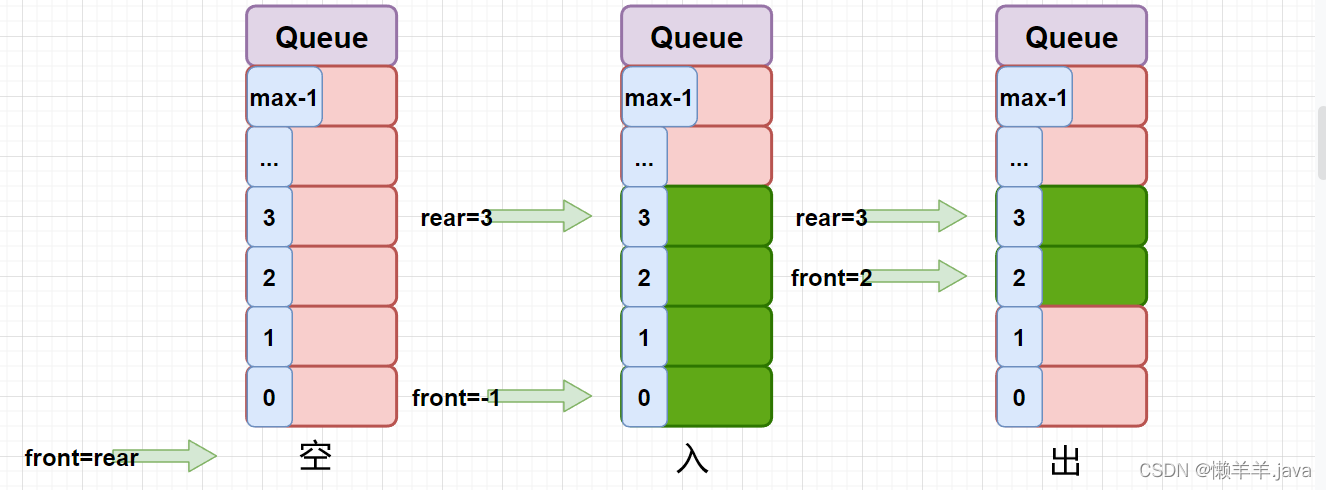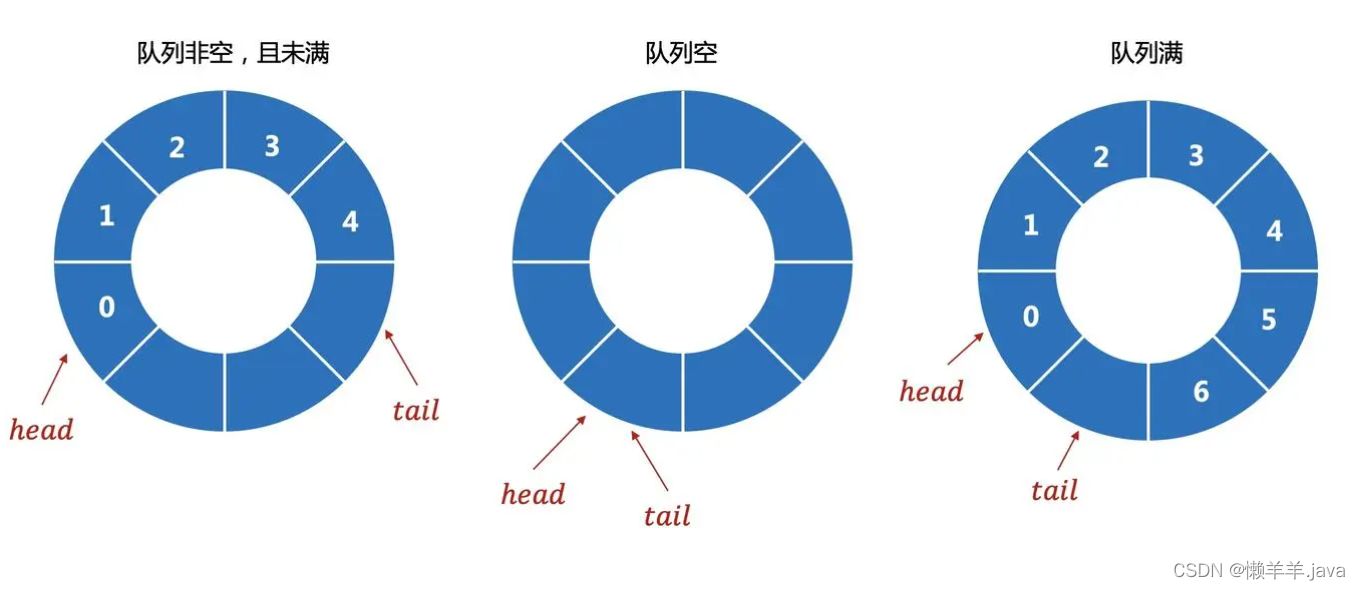前言
队列类似于数组,遵循着先入先出的原则,实际生活中的排队场景就是这一特征的体现,队首的人总是先完成办理。独特的数据结构特征注定会应用于特殊的场景
队列
队列的入队和出队操作的时间复杂度均为O(1)
队列是一个有序列表,遵循先入先出的原则,这也是此数据结构的特性所在。即:先存入队列的数据,要先取出。后存入的要后取出,以(front/rear)来实现定位元素位置
示意图如下所示

数组模拟队列
利用数组模拟队列可以深刻理解队列的特性,实现它的过程,代码与数据结构相结合更是提升了自己设计程序的能力,结合示意图实现思路如下:
1.通过面向对象的思想将队列看作一个对象Queue
2.定义模拟数组arr[ ]与最大容量maxsize
3.通过定义两个变量(front/rear)来模拟定位的指针,每当一个元素入队后,指针rear就向后移一位(rear++),将用户输入的数值扫描,获取后赋值到数组的指定位置,实现入队添加
4.通过front来实现“先出”,先出的元素出队后,front指针就向后移,每出一个指针向后移一位(front++),队列是如何保证每次对元素的操作都”遵规守纪“的?就是靠的rear/front的各司其职!出队动front不动rear,入队动rear不动front
5.上述功能实现的前提是对列不为空,要在每一次操作的前加上队列不为空的if判断
public class ArrayQueueDemo {
public static void main(String[] args) {
//测试一把
//创建一个队列
ArrayQueue queue = new ArrayQueue(3);
char key = ' '; //接收用户输入
Scanner scanner = new Scanner(System.in);//
boolean loop = true;
//输出一个菜单
while(loop) {
System.out.println("s(show): 显示队列");
System.out.println("e(exit): 退出程序");
System.out.println("a(add): 添加数据到队列");
System.out.println("g(get): 从队列取出数据");
System.out.println("h(head): 查看队列头的数据");
key = scanner.next().charAt(0);//接收一个字符
switch (key) {
case 's':
queue.showQueue();
break;
case 'a':
System.out.println("输出一个数");
int value = scanner.nextInt();
queue.addQueue(value);
break;
case 'g': //取出数据
try {
int res = queue.getQueue();
System.out.printf("取出的数据是%d\n", res);
} catch (Exception e) {
// TODO: handle exception
System.out.println(e.getMessage());
}
break;
case 'h': //查看队列头的数据
try {
int res = queue.headQueue();
System.out.printf("队列头的数据是%d\n", res);
} catch (Exception e) {
// TODO: handle exception
System.out.println(e.getMessage());
}
break;
case 'e': //退出
scanner.close();
loop = false;
break;
default:
break;
}
}
System.out.println("程序退出~~");
}
}
// 使用数组模拟队列-编写一个ArrayQueue类
class ArrayQueue {
private int maxSize; // 表示数组的最大容量
private int front; // 队列头
private int rear; // 队列尾
private int[] arr; // 该数据用于存放数据, 模拟队列
// 创建队列的构造器
public ArrayQueue(int arrMaxSize) {
maxSize = arrMaxSize;
arr = new int[maxSize];
front = -1; // 指向队列头部,分析出front是指向队列头的前一个位置.
rear = -1; // 指向队列尾,指向队列尾的数据(即就是队列最后一个数据)
}
// 判断队列是否满
public boolean isFull() {
return rear == maxSize - 1;
}
// 判断队列是否为空
public boolean isEmpty() {
return rear == front;
}
// 添加数据到队列
public void addQueue(int n) {
// 判断队列是否满
if (isFull()) {
System.out.println("队列满,不能加入数据~");
return;
}
rear++; // 让rear 后移
arr[rear] = n;
}
// 获取队列的数据, 出队列
public int getQueue() {
// 判断队列是否空
if (isEmpty()) {
// 通过抛出异常
throw new RuntimeException("队列空,不能取数据");
}
front++; // front后移
return arr[front];
}
// 显示队列的所有数据
public void showQueue() {
// 遍历
if (isEmpty()) {
System.out.println("队列空的,没有数据~~");
return;
}
for (int i = 0; i < arr.length; i++) {
System.out.printf("arr[%d]=%d\n", i, arr[i]);
}
}
// 显示队列的头数据, 注意不是取出数据
public int headQueue() {
// 判断
if (isEmpty()) {
throw new RuntimeException("队列空的,没有数据~~");
}
return arr[front + 1];
}
}
数组模拟环形队列

1.front变量的含义做一个调整:front就指向队列的第一个元素,也就是说arr[front]就是队列的第一个元素front的初始值=o
2.rear变量的含义做一个调整:rear指向队列的最后一个元素的后一个位置.因为希望空出一个空间做为约定.rear的初始值=o
3.当队列满时,条件是(rear +1) % maxSize = front【满】
4.对队列为空的条件,rear == front空
5.当我们这样分析,队列中有效的数据的个数(rear+ maxSize -front)% maxSize // rear=1front=0
public class CircleArrayQueueDemo {
public static void main(String[] args) {
//测试一把
System.out.println("数组模拟环形队列~~~");
// 创建一个环形队列
CircleArray queue = new CircleArray(4); //说明设置4, 其队列的有效数据最大是3
char key = ' '; // 接收用户输入
Scanner scanner = new Scanner(System.in);//
boolean loop = true;
// 输出一个菜单
while (loop) {
System.out.println("s(show): 显示队列");
System.out.println("e(exit): 退出程序");
System.out.println("a(add): 添加数据到队列");
System.out.println("g(get): 从队列取出数据");
System.out.println("h(head): 查看队列头的数据");
key = scanner.next().charAt(0);// 接收一个字符
switch (key) {
case 's':
queue.showQueue();
break;
case 'a':
System.out.println("输出一个数");
int value = scanner.nextInt();
queue.addQueue(value);
break;
case 'g': // 取出数据
try {
int res = queue.getQueue();
System.out.printf("取出的数据是%d\n", res);
} catch (Exception e) {
// TODO: handle exception
System.out.println(e.getMessage());
}
break;
case 'h': // 查看队列头的数据
try {
int res = queue.headQueue();
System.out.printf("队列头的数据是%d\n", res);
} catch (Exception e) {
// TODO: handle exception
System.out.println(e.getMessage());
}
break;
case 'e': // 退出
scanner.close();
loop = false;
break;
default:
break;
}
}
System.out.println("程序退出~~");
}
}
class CircleArray {
private int maxSize; // 表示数组的最大容量
//front 变量的含义做一个调整: front 就指向队列的第一个元素, 也就是说 arr[front] 就是队列的第一个元素
//front 的初始值 = 0
private int front;
//rear 变量的含义做一个调整:rear 指向队列的最后一个元素的后一个位置. 因为希望空出一个空间做为约定.
//rear 的初始值 = 0
private int rear; // 队列尾
private int[] arr; // 该数据用于存放数据, 模拟队列
public CircleArray(int arrMaxSize) {
maxSize = arrMaxSize;
arr = new int[maxSize];
}
// 判断队列是否满
public boolean isFull() {
return (rear + 1) % maxSize == front;
}
// 判断队列是否为空
public boolean isEmpty() {
return rear == front;
}
// 添加数据到队列
public void addQueue(int n) {
// 判断队列是否满
if (isFull()) {
System.out.println("队列满,不能加入数据~");
return;
}
//直接将数据加入
arr[rear] = n;
//将 rear 后移, 这里必须考虑取模
rear = (rear + 1) % maxSize;
}
// 获取队列的数据, 出队列
public int getQueue() {
// 判断队列是否空
if (isEmpty()) {
// 通过抛出异常
throw new RuntimeException("队列空,不能取数据");
}
// 这里需要分析出 front是指向队列的第一个元素
// 1. 先把 front 对应的值保留到一个临时变量
// 2. 将 front 后移, 考虑取模
// 3. 将临时保存的变量返回
int value = arr[front];
front = (front + 1) % maxSize;
return value;
}
// 显示队列的所有数据
public void showQueue() {
// 遍历
if (isEmpty()) {
System.out.println("队列空的,没有数据~~");
return;
}
// 思路:从front开始遍历,遍历多少个元素
// 动脑筋
for (int i = front; i < front + size() ; i++) {
System.out.printf("arr[%d]=%d\n", i % maxSize, arr[i % maxSize]);
}
}
// 求出当前队列有效数据的个数
public int size() {
// rear = 2
// front = 1
// maxSize = 3
return (rear + maxSize - front) % maxSize;
}
// 显示队列的头数据, 注意不是取出数据
public int headQueue() {
// 判断
if (isEmpty()) {
throw new RuntimeException("队列空的,没有数据~~");
}
return arr[front];
}
}